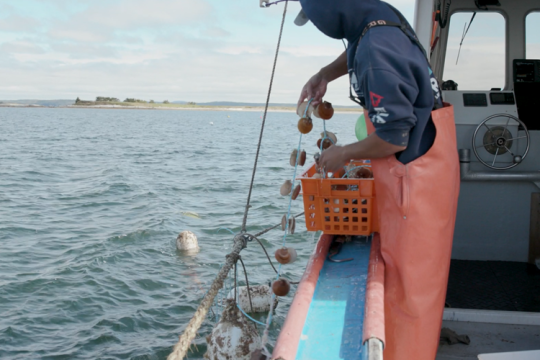We continue our series to introduce the people who work at the Northeast Fisheries Science Center. Each month we feature a new "face" from the Center's five laboratories and share with you a bit about who they are, what they do at the Center, and what they enjoy doing in their spare time. Meghana Parikh is a research veterinary medical officer in the Aquaculture Sustainability Branch in the Ecosystems & Aquaculture Division and is located at our Milford Laboratory in Milford, Connecticut.
Where did you grow up?
Bethlehem, Pennsylvania. I didn’t grow up by the ocean, but I was always fascinated by it. I told people I wanted to be a vet or marine biologist when I grew up—now I get to do both. Some of my earliest memories are sitting in my elementary school’s library, reading books about marine biology for hours. Neither of my parents particularly liked animals, so I didn’t grow up with pets, but I enjoyed riding horses. My goal of becoming a veterinarian started with an interest in equine medicine.
Where did you go to school, in what subjects did you get your degree(s)?
As I was applying to colleges, I participated in a summer ecology course in England, which sparked my interest in ecology and environmental science. It was there that I became passionate about conservation.
I started college at the University of California Berkeley as an environmental policy and law major. I quickly switched to molecular environmental biology, when I realized that my passion was in the sciences. During college, I worked in a marine invertebrate behavior lab, with cuttlefish, octopuses, and stomatopods (mantis shrimp)—some of the most unique invertebrates! I also took prerequisite courses for the health track, as I was considering veterinary medicine. I worked with a race-track veterinarian and with private-practice vets. While I learned a lot, neither seemed a perfect fit for my future career.
I earned my Bachelor of Science degree in molecular environmental biology. Then I interned at the Mystic Aquarium in Connecticut with their marine mammal rehabilitation clinic. Seeing how much veterinarians can do to contribute to conservation solidified my interest in veterinary medicine.
From there, I headed to the University of Pennsylvania School of Veterinary Medicine, where I earned my Veterinary Medical Doctorate. PennVet does a lot of work with food animal production, including with dairy farmers. I loved working with farmers—getting to know them and having the sense that helping them was a way to serve society. This left me with questions like, how do we feed the world? And where do veterinarians fit into that?
I first learned about aquaculture during an aquatic veterinary course I took through Cornell University in Bristol, Rhode Island. My interest in aquaculture grew, as it plays a significant role in meeting global protein demand. I always wanted to work at the population level—individual medicine never quite clicked. I take a “one health” approach to my work, which acknowledges that animal, human, and environmental health are all connected. In order to solve large challenges, we need to consider the interrelatedness of these different areas and cross boundaries to work together. Aquaculture allowed me to span all three of these areas.
During veterinary school, I did some career exploration through clinical externships. I went to Mississippi and worked at a diagnostic lab serving the catfish industry. I also spent time in Florida with Mote Marine Lab’s aquaculture group and a private company growing sturgeon for caviar.
How did you come to work at the Northeast Fisheries Science Center?
After I graduated from veterinary school, I moved to Nashville, Tennessee. I knew I wanted to work on population health after talking to vets doing this in different sectors. It was apparent that having an epidemiology background was essential for me to achieve my career goals.
Epidemiology is all about disease dynamics and assessing risk in a population. This is what drove me to earn my Master’s of Public Health from Vanderbilt University. My training led to a job at the Tennessee Department of Health investigating healthcare associated infections in human hospitals. In this role I learned so much about surveillance and using data for action. I am eager to use this foundation in epidemiology to support the Northeast Fisheries Science Center.
Finding this job in Milford was a mix of professional and personal for me. I was interested in combining my veterinary skillset with epidemiology, and working with aquatic species again. And, my husband’s family lives in Connecticut. He had just finished medical school and applied to Yale University for his medical residency. It worked out great when we both landed the jobs we applied for. We are very excited about being back in the Northeast, close to family and the ocean!
What do you do at the Science Center?
I am new to the Science Center, so naturally I am doing a lot of learning, reading, and meeting everyone (virtually of course). I’ve been enjoying meeting everyone here and it's been inspiring to learn how everyone is contributing to aquaculture and fisheries in the Northeast.
Much like when I worked with dairy farmers during vet school, I want to get to know the shellfish growers. Knowing how the shellfish industry works, the challenges growers face, and the environmental parameters that exist in aquatic systems. All these factors will inform the work I do at the Milford Lab.
As I mentioned, I’m trained in veterinary medicine and epidemiology, making this role a great fit. For many diseases affecting shellfish, the transmission dynamics are still unknown. Yet growers and managers need to know what the risk is of disease affecting U.S. shellfish farmers. I want to help people improve their livelihoods and create sustainable food products.
What are some of your hobbies?
In addition to spending time with my family, I love hiking, paddleboarding, kayaking and cooking. Since I moved to Milford, I try to go to the beach every couple of weeks. I had never been on Long Island Sound before I met my husband. It is so nice and calm—a perfect place to relax, especially in these crazy times! I went paddleboarding at Walnut Beach recently and really enjoyed it!
I also love to eat seafood, oysters included! I’ll admit I’ve never shucked one—seems like something I need to learn!







